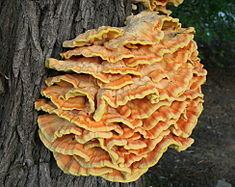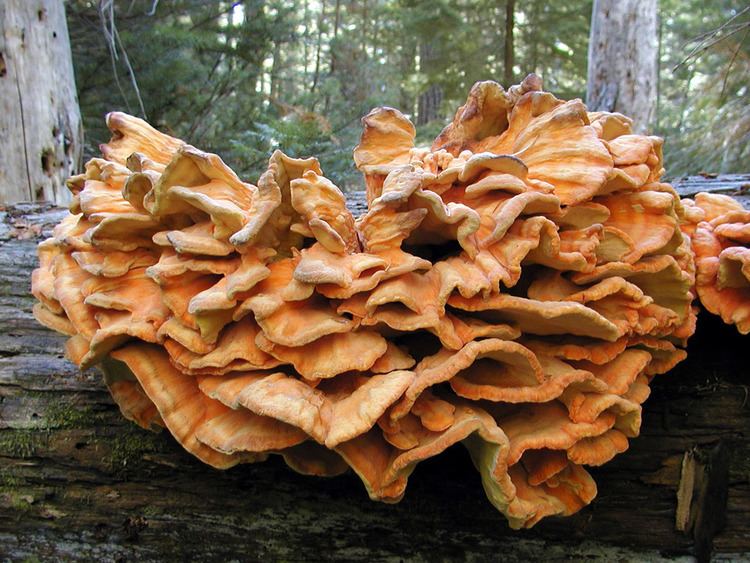Kingdom Fungi Higher classification Polyporaceae | Division Basidiomycota Scientific name Laetiporus Rank Genus | |
Similar Hen‑of‑the‑wood, True ls, Beefsteak Fungus, Chanterelle, Lobster mushroom | ||
Laetiporus sulphureus bracket fungus fungi polyporaceae sulphur shelf
Laetiporus is a genus of edible mushrooms found throughout much of the world. Some species, especially Laetiporus sulphureus, are commonly known as sulphur shelf, chicken of the woods, the chicken mushroom, or the chicken fungus because many think they taste like chicken. The name "chicken of the woods" is not to be confused with the edible polypore, Maitake (Grifola frondosa) known as "hen of the woods", or with Lyophyllum decastes, known as the "fried chicken mushroom".
Contents
- Laetiporus sulphureus bracket fungus fungi polyporaceae sulphur shelf
- Chicken of the woods mushroom laetiporus sulphureus
- Description
- Phylogenetics
- Edibility
- Species
- References
Chicken of the woods mushroom laetiporus sulphureus
Description

Individual "shelves" range from 5–25 cm (2"-10" inches) across. These shelves are made up of many tiny tubular filaments (hyphae). The mushroom grows in large brackets - some have been found that weigh over 45 kg (100 pounds). It is most commonly found on wounds of trees, mostly oak, though it is also frequently found on eucalyptus, yew, sweet chestnut, and willow, as well as conifers in some species. Laetiporus species produce brown rot in the host on which they grow.

Young fruiting bodies are characterized by a moist, rubbery, sulphur-yellow to orange body sometimes with bright orange tips. Older brackets become pale and brittle almost chalk like, mildly pungent, and are often dotted with beetle or slug/woodlouse holes. Similar species include Laetiporus gilbertsonii (fluorescent pink, more amorphous) and L. coniferica (common in the western United States, especially on red fir trees). Edibility traits for the different species have not been well documented, although all are generally considered edible with caution.

The sulphur shelf mushroom sometimes comes back year after year when the weather suits its sporulation preferences. From late spring to early autumn, the sulphur shelf thrives, making it a boon to mushroom hunters and a bane to those concerned about the health of their trees. This fungus causes a brown cubical rot and embrittlement which in later stages ends in the collapse of the host tree, as it can no longer flex and bend in the wind.
Phylogenetics
Phylogenetic analyses of ITS, nuclear large subunit and mitochondrial small subunit rDNA sequences from a variety of North American species have delineated five distinct clades within the core Laetiporus clade: sulphureus clade I contains white-pored L. sulphureus isolates, while sulphureus clade II contains yellow-pored L. sulphureus isolates.
In addition, phylogenetic clades have been identified from Japan, Hawaii, South America, Europe, and South Africa.
Edibility
The mushroom can be prepared in most ways that one can prepare chicken meat. It can also be used as a substitute for chicken in a vegetarian diet. Additionally, it can be frozen for long periods of time and retain its edibility. In certain parts of Germany and North America, it is considered a delicacy.
In some cases eating the mushroom "causes mild reactions . . . for example, "swollen lips" or in rare cases "nausea, vomiting, dizziness and disorientation" to those who are sensitive. This is believed to be due to a number of factors that range from very bad allergies to the mushroom's protein, to toxins absorbed by the mushroom from the wood it grows on (for example, eucalyptus or cedar or yew) to simply eating specimens that have decayed past their prime. As such, many field guides request that those who eat Laetiporus exercise caution by only eating fresh, young brackets and begin with small quantities to see how well it sits in their stomach.
Laetiporus sulphureus has potent ability to inhibit staph bacteria (Staphylococcus aureus), as well as moderate ability to inhibit the growth of Bacillus subtilis.
